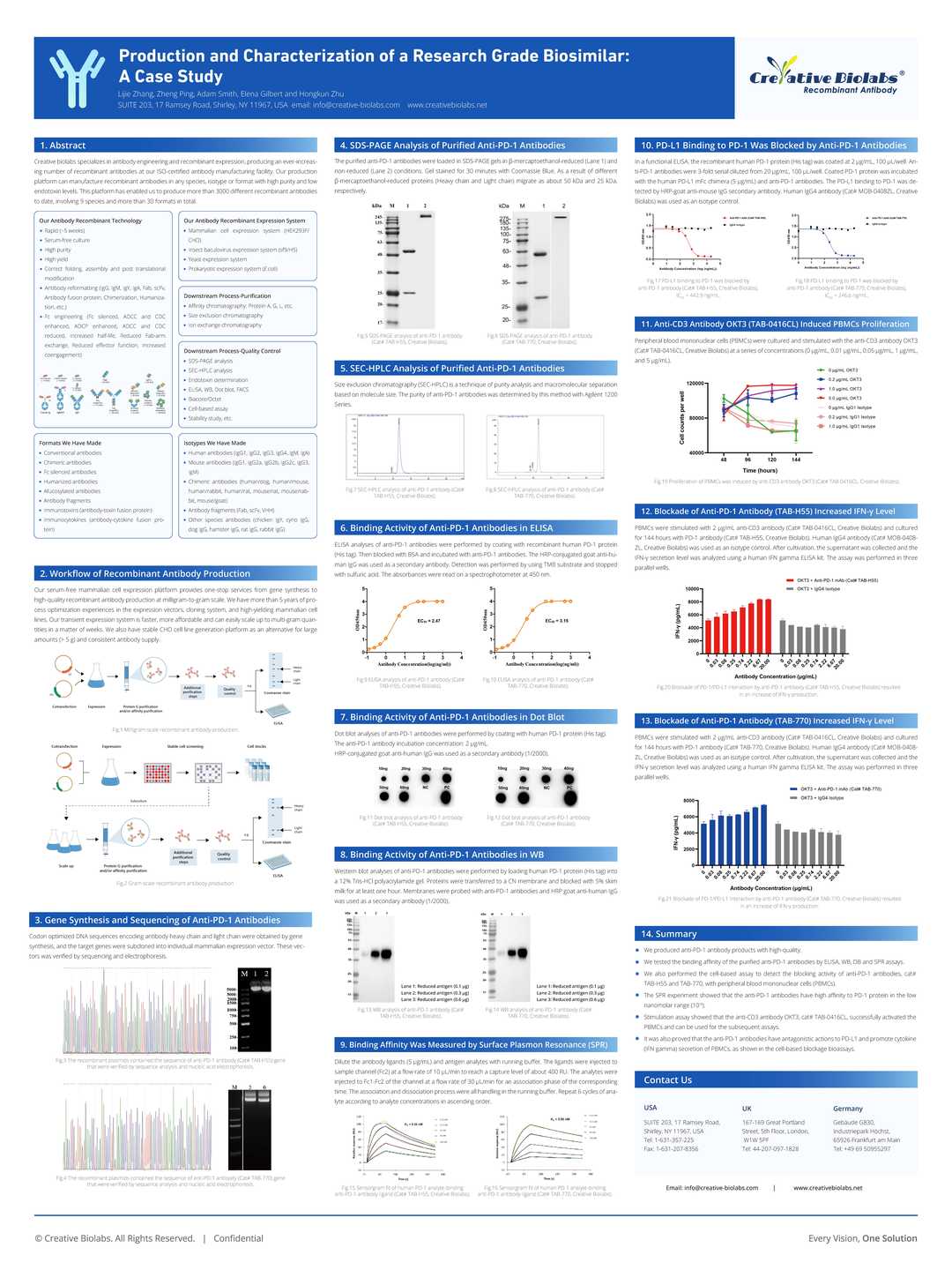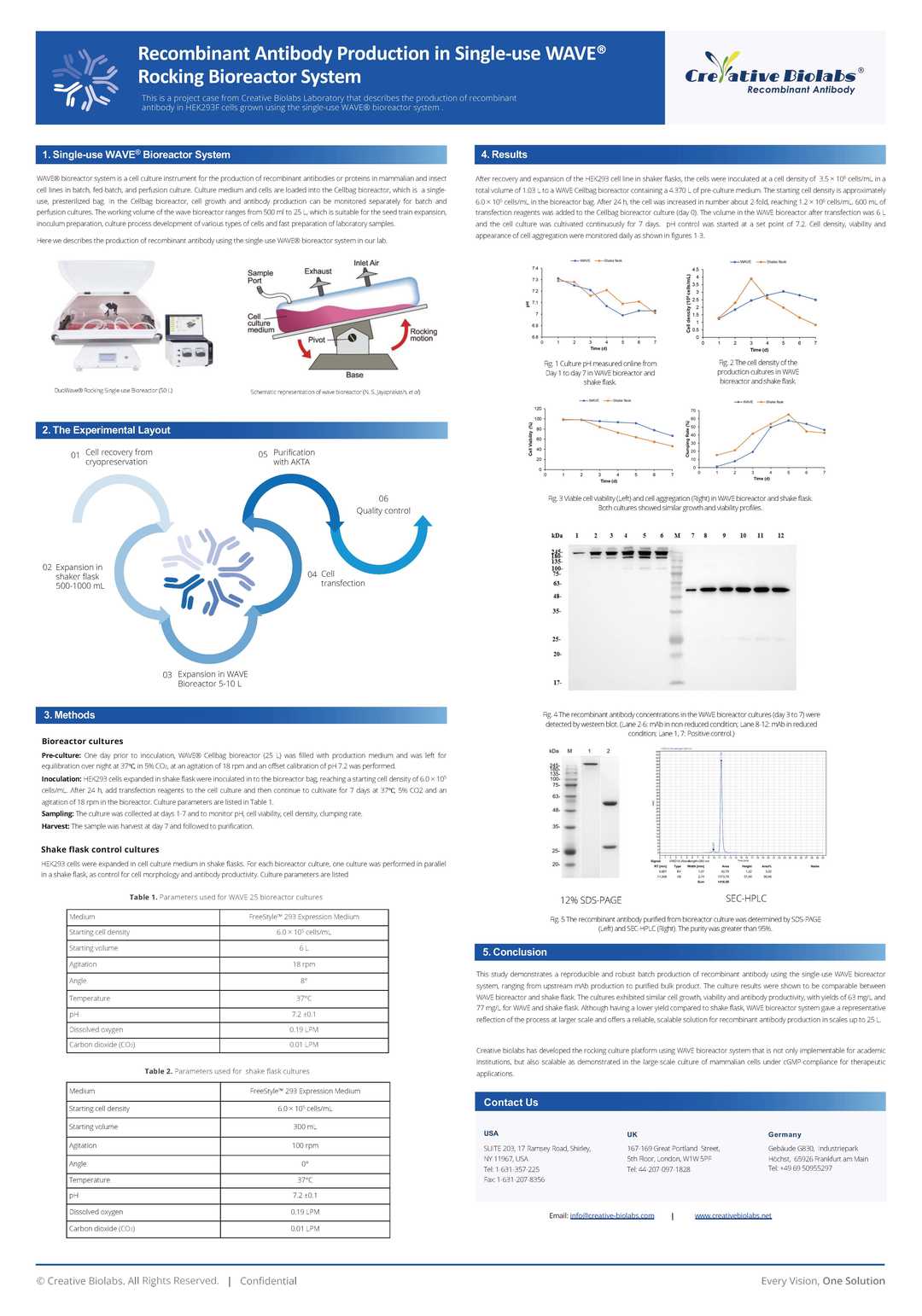Anti-Human 4-1BB Recombinant Antibody (TAB-179)
CAT#: TAB-179
Recombinant monoclonal antibody to 4-1BB. This anti-4-1BB antibody is a fully human IgG4 monoclonal antibody targeting the CD137 receptor. It specifically binds to and activates CD137-expressing immune cells, stimulating an immune response, in particular a cytotoxic T cell response, against tumor cells.





Specifications
- Immunogen
- Ectodomain of human 4-1BB recombinant protein.
- Host Species
- Human
- Derivation
- Human
- Type
- IgG4 - kappa
- Specificity
- Tested positive against native human antigen.
- Species Reactivity
- Human
- Applications
- ELISA, FC, IP, FuncS, IF, Neut, ICC
- MW
- 145.8 kDa
- Related Disease
- Tumors
Product Property
- Purity
- Purity >95% by SDS-PAGE.
- Storage
- At -20°C for one year.
Applications
- Application Notes
- The TNFRSF9 antibody has been reported in applications of H&E staining, Activ, Stim, IF.
Target
Customer Review
There are currently no Customer reviews or questions for TAB-179. Click the button above to contact us or submit your feedback about this product.
 Michael Johnson
Michael Johnson21.Sep,23
 Laura Brown
Laura Brown14.Nov,22
 John Wilson
John Wilson19.Jun,21
Q&As
-
Is the anti-Human 4-1BB antibody suitable for use in ELISA?
A: Yes, the anti-Human 4-1BB antibody (TAB-179) is suitable for use in ELISA. It has been validated for use in such assays and provides reliable detection of 4-1BB.
-
What is the optimal dilution for using the anti-Human 4-1BB antibody in Western blotting?
A: The optimal dilution for using the anti-Human 4-1BB antibody (TAB-179) in Western blotting is typically 1:500 to 1:2000. It is advisable to perform a dilution series to determine the best working concentration for your specific experimental conditions.
-
Can the anti-Human 4-1BB antibody be used in flow cytometry analysis?
A: Yes, the anti-Human 4-1BB antibody (TAB-179) can be used in flow cytometry analysis. It is specifically designed to bind to 4-1BB, making it suitable for detecting 4-1BB-expressing cells in flow cytometry.
-
Is the anti-Human 4-1BB antibody effective in blocking 4-1BB interactions in vitro?
A: Yes, the anti-Human 4-1BB antibody (TAB-179) is effective in blocking 4-1BB interactions in vitro. It can inhibit the interaction between 4-1BB and its ligands, which is useful for studying the immune signaling pathways involving 4-1BB.
-
What are the storage recommendations for the anti-Human 4-1BB antibody?
A: The recommended storage condition for the anti-Human 4-1BB antibody (TAB-179) is at -20°C or lower. For short-term storage, it can be kept at 2-8°C. To ensure stability, avoid repeated freeze-thaw cycles.
View the frequently asked questions answered by Creative Biolabs Support.
Citations
-
Reithofer, Manuel, et al. "4-1BB costimulation promotes bystander activation of human CD8 T cells." European Journal of Immunology 51.3 (2021): 721-733. https://doi.org/10.1002/eji.202048762This study explores the impact of 4-1BB costimulation on human CD8 T cells, particularly focusing on bystander activation. The researchers used engineered antigen-presenting cells (eAPCs) expressing viral epitopes and costimulatory ligands to study how different costimulatory signals affect CD8 T cell responses. They found that while CD28 costimulation enhances antigen-specific CD8 T cell responses, 4-1BB costimulation, either through 4-1BB ligand (4-1BBL) or the agonist antibody urelumab, induces significant bystander proliferation of CD8 T cells and expansion of NK cells. This bystander activation is independent of the presented antigens and is characterized by increased cytokine production and cytotoxic activity.
Creative Biolabs contributed significantly to this research by providing the 4-1BB agonist antibody urelumab (Cat# TAB-179). This antibody was crucial for experiments investigating the effects of 4-1BB costimulation on CD8 T cells and NK cells. The use of urelumab enabled the researchers to demonstrate the unique ability of 4-1BB signals to promote bystander activation, thereby advancing the understanding of how 4-1BB costimulation can be harnessed in cancer immunotherapy while also highlighting potential off-target effects that need to be managed. -
Upadhyaya, Punit, et al. "Anticancer immunity induced by a synthetic tumor-targeted CD137 agonist." Journal for immunotherapy of cancer 9.1 (2021). https://doi.org/10.1136/jitc-2020-001762This study investigates the development and efficacy of synthetic tumor-targeted CD137 agonists (TICAs) in inducing anticancer immunity. By using constrained bicyclic peptides (Bicycles) to create TICAs that link tumor antigens (like EphA2) with costimulatory receptors (such as CD137), the researchers were able to selectively activate these receptors in the presence of tumor cells. The study demonstrated that the EphA2/CD137 TICA (BCY12491) efficiently stimulated human peripheral blood mononuclear cells and resulted in significant tumor regression in mouse models. This approach highlights the potential of TICAs to provide effective and targeted cancer immunotherapy with a wide therapeutic index.
Creative Biolabs contributed to this research by supplying the anti-CD137 monoclonal antibody urelumab (Cat# TAB-179). This antibody was crucial for the experiments that investigated the effects of 4-1BB (CD137) costimulation on immune cells. The provision of this key reagent allowed researchers to demonstrate the unique capabilities of TICAs in promoting targeted tumor immunity, thereby supporting the development of new therapeutic strategies in cancer treatment.
Cite This Product
To accurately reference this product in your publication, please use the following citation information:
(Creative Biolabs Cat# TAB-179, RRID: AB_3111852)
Submit Your Publication
Published with our product? Submit your paper and receive a 10% discount on your next order! Share your research to earn exclusive rewards.
Biosimilar Overview
Please refer to Urelumab Overview to learn more about the mechanism of action, clinical projects, and approved drugs of Urelumab.
Downloadable Resources
Download resources about recombinant antibody development and antibody engineering to boost your research.
Product Notes
This is a product of Creative Biolabs' Hi-Affi™ recombinant antibody portfolio, which has several benefits including:
• Increased sensitivity
• Confirmed specificity
• High repeatability
• Excellent batch-to-batch consistency
• Sustainable supply
• Animal-free production
See more details about Hi-Affi™ recombinant antibody benefits.
Datasheet
MSDS
COA
Certificate of Analysis LookupTo download a Certificate of Analysis, please enter a lot number in the search box below. Note: Certificate of Analysis not available for kit components.
Protocol & Troubleshooting
We have outlined the assay protocols, covering reagents, solutions, procedures, and troubleshooting tips for common issues in order to better assist clients in conducting experiments with our products. View the full list of Protocol & Troubleshooting.
See other products for "TNFRSF9"
Select a product category from the dropdown menu below to view related products.
| CAT | Product Name | Application | Type |
|---|---|---|---|
| MOB-1443z | Mouse Anti-TNFRSF9 Recombinant Antibody (clone 29H11) | ELISA, FC, IP, FuncS | Mouse IgG1 |
| MOB-2279MZ | Recombinant Mouse Anti-Human TNFRSF9 Antibody (clone 5C5 (5C5-2)), FITC-Conjugated | FC | Mouse antibody |
| HPAB-0253-CN | Human Anti-TNFRSF9 Recombinant Antibody (HPAB-0253-CN) | ELISA, FC | Human IgG |
| HPAB-0254-CN | Human Anti-TNFRSF9 Recombinant Antibody (HPAB-0254-CN) | ELISA, FC | Human IgG |
| HPAB-0255-CN | Human Anti-TNFRSF9 Recombinant Antibody (HPAB-0255-CN) | ELISA, FC | Human IgG4, λ |
| CAT | Product Name | Application | Type |
|---|---|---|---|
| AGTO-G063S | Anti-TNFRSF9 immunotoxin (scFv)-Sap | Cytotoxicity assay, Function study |
| CAT | Product Name | Application | Type |
|---|---|---|---|
| Gly-064LC | Recombinant Anti-Human TNFRSF9 Antibody (Fc glycosylation/High-mannose glycosylated) | ELISA | Human antibody |
| CAT | Product Name | Application | Type |
|---|---|---|---|
| Gly-064LC-1 | Recombinant Anti-Human TNFRSF9 Antibody (Fc glycosylation/High-mannose glycosylated) | ELISA | Human antibody |
| CAT | Product Name | Application | Type |
|---|---|---|---|
| TAB-0611CLV | Human Anti-TNFRSF9 Recombinant Antibody (TAB-0611CLV) | ELISA, FC | Humanized IgG1 |
| TAB-0612CLV | Human Anti-TNFRSF9 Recombinant Antibody (TAB-0612CLV) | ELISA, FC | Humanized IgG4 |
| TAB-0611CLV-F(E) | Human Anti-TNFRSF9 Recombinant Antibody; Fab Fragment (TAB-0611CLV-F(E)) | ELISA, FC | Humanized Fab |
| TAB-0612CLV-F(E) | Human Anti-TNFRSF9 Recombinant Antibody; Fab Fragment (TAB-0612CLV-F(E)) | ELISA | Humanized Fab |
| TAB-0611CLV-S(P) | Human Anti-TNFRSF9 Recombinant Antibody; scFv Fragment (TAB-0611CLV-S(P)) | ELISA, FC | Humanized scFv |
| CAT | Product Name | Application | Type |
|---|---|---|---|
| TAB-0613CLV | Human Anti-TNFRSF9 Recombinant Antibody (TAB-0613CLV) | ELISA | Chimeric (mouse/human) IgG1 |
| TAB-0614CLV | Human Anti-TNFRSF9 Recombinant Antibody (TAB-0614CLV) | ELISA | Chimeric (mouse/human) IgG1 |
| TAB-0613CLV-F(E) | Human Anti-TNFRSF9 Recombinant Antibody; Fab Fragment (TAB-0613CLV-F(E)) | ELISA | Chimeric (mouse/human) Fab |
| TAB-0614CLV-F(E) | Human Anti-TNFRSF9 Recombinant Antibody; Fab Fragment (TAB-0614CLV-F(E)) | ELISA | Chimeric (mouse/human) Fab |
| TAB-0613CLV-S(P) | Mouse Anti-TNFRSF9 Recombinant Antibody; scFv Fragment (TAB-0613CLV-S(P)) | ELISA | Mouse scFv |
| CAT | Product Name | Application | Type |
|---|---|---|---|
| NEUT-2167CQ | Rat Anti-Tnfrsf9 Recombinant Antibody (clone CBL332) | Block, WB | Rat IgG2b |
| NEUT-2168CQ | Hamster Anti-Tnfrsf9 Recombinant Antibody (clone 17B5) | FC, Block | Hamster IgG |
| CAT | Product Name | Application | Type |
|---|---|---|---|
| NEUT-2169CQ | Rat Anti-Tnfrsf9 Recombinant Antibody (NEUT-2169CQ) | Neut, WB | Rat IgG2 |
| CAT | Product Name | Application | Type |
|---|---|---|---|
| TAB-457CQ | Anti-Human TNFRSF9 Recombinant Antibody (TAB-457CQ) | ELISA, IHC, FC, IP, IF, FuncS | IgG2, λ |
| CAT | Product Name | Application | Type |
|---|---|---|---|
| HPAB-0253-CN-S(P) | Human Anti-TNFRSF9 Recombinant Antibody; scFv Fragment (HPAB-0253-CN-S(P)) | ELISA, FC | Human scFv |
| HPAB-0254-CN-S(P) | Human Anti-TNFRSF9 Recombinant Antibody; scFv Fragment (HPAB-0254-CN-S(P)) | ELISA, FC | Human scFv |
| HPAB-0255-CN-S(P) | Human Anti-TNFRSF9 Recombinant Antibody; scFv Fragment (HPAB-0255-CN-S(P)) | ELISA, FC | Human scFv |
| HPAB-0256-CN-S(P) | Human Anti-TNFRSF9 Recombinant Antibody; scFv Fragment (HPAB-0256-CN-S(P)) | FC | Human scFv |
| HPAB-0257-CN-S(P) | Human Anti-TNFRSF9 Recombinant Antibody; scFv Fragment (HPAB-0257-CN-S(P)) | FC | Human scFv |
| CAT | Product Name | Application | Type |
|---|---|---|---|
| HPAB-0253-CN-F(E) | Human Anti-TNFRSF9 Recombinant Antibody; Fab Fragment (HPAB-0253-CN-F(E)) | ELISA, FC | Human Fab |
| HPAB-0254-CN-F(E) | Human Anti-TNFRSF9 Recombinant Antibody; Fab Fragment (HPAB-0254-CN-F(E)) | ELISA, FC | Human Fab |
| HPAB-0255-CN-F(E) | Human Anti-TNFRSF9 Recombinant Antibody; Fab Fragment (HPAB-0255-CN-F(E)) | ELISA, FC | Human Fab |
| HPAB-0256-CN-F(E) | Human Anti-TNFRSF9 Recombinant Antibody; Fab Fragment (HPAB-0256-CN-F(E)) | FC | Human Fab |
| HPAB-0257-CN-F(E) | Human Anti-TNFRSF9 Recombinant Antibody; Fab Fragment (HPAB-0257-CN-F(E)) | FC | Human Fab |
| CAT | Product Name | Application | Type |
|---|---|---|---|
| AFC-TAB-457CQ | Afuco™ Anti-TNFRSF9 ADCC Recombinant Antibody, ADCC Enhanced (AFC-TAB-457CQ) | ELISA, IHC, FC, IP, IF, FuncS | ADCC enhanced antibody |
| AFC-TAB-179 | Afuco™ Anti-TNFRSF9 ADCC Recombinant Antibody, ADCC Enhanced (AFC-TAB-179) | ELISA, FC, IP, FuncS, IF, Neut | ADCC enhanced antibody |
| CAT | Product Name | Application | Type |
|---|---|---|---|
| VS-0724-XY51 | Rat Anti-Tnfrsf9 Agonistic Antibody (VS-0724-XY51) | Agonistic assays | Rat IgG2a |
| VS-0724-XY52 | Rabbit Anti-TNFRSF9 Agonistic Antibody (VS-0724-XY52) | FC, Agonistic assays, CyTOF® | Rabbit IgG |
| VS-0724-XY53 | Human Anti-TNFRSF9 Agonistic Antibody (VS-0724-XY53) | ELISA, Agonistic assays | Human IgG1 |
| VS-0724-XY54 | Rabbit Anti-TNFRSF9 Agonistic Antibody (clone RbBBK4) | ELISA, FC, Agonistic assays | Rabbit IgG, kappa |
| VS-0724-XY55 | Mouse Anti-TNFRSF9 Agonistic Antibody (VS-0724-XY55) | ELISA, FC, Agonistic assays | Mouse IgG1, kappa |
| CAT | Product Name | Application | Type |
|---|---|---|---|
| VS-1024-XY76 | Mouse Anti-NHP TNFRSF9 Recombinant Antibody (VS-1024-XY76) | FC | Mouse IgG1, kappa |
| CAT | Product Name | Application | Type |
|---|---|---|---|
| VS-0225-XY224 | CytoStream™ Rat Anti-TNFRSF9 Recombinant Antibody (VS-0225-XY224) | FC | Rat IgG1, kappa |
| VS-0225-XY225 | CytoStream™ Mouse Anti-TNFRSF9 Recombinant Antibody (VS-0225-XY225) | FC | Mouse IgG1, kappa |
| CAT | Product Name | Application | Type |
|---|---|---|---|
| VS-0325-FY100 | Human Anti-TNFRSF9 (clone 39E3) scFv-Fc Chimera | FC | Human IgG1, scFv-Fc |
| CAT | Product Name | Application | Type |
|---|---|---|---|
| VS-0425-YC223 | Recombinant Anti-TNFRSF9 Vesicular Antibody, EV Displayed (VS-0425-YC223) | ELISA, FC, Neut, Cell-uptake |
| CAT | Product Name | Application | Type |
|---|---|---|---|
| VS-0525-XY7386 | Anti-TNFRSF9 Immunohistochemistry Kit | IHC |
| CAT | Product Name | Application | Type |
|---|---|---|---|
| VS-0525-YC236 | Recombinant Anti-TNFRSF9 Biparatopic Antibody, Tandem scFv | ELISA, IF, IP | Tandem scFv |
| CAT | Product Name | Application | Type |
|---|---|---|---|
| VS-0825-YC341 | SmartAb™ Recombinant Anti-TNFRSF9 pH-dependent Antibody (VS-0825-YC341) | ELISA, FC, IP IF, Neut, ICC | Human IgG4 kappa |
Popular Products

Application: WB, FC, IP, ELISA, Neut, FuncS, IF

Application: WB, Neut, ELISA, IF, IP, FuncS, FC

Application: ELISA, WB, BLI, SPR

Application: Block, Cyt, FuncS, Inhib

Application: ELISA, IHC, FC, IP, IF, FuncS

Application: ELISA, IHC, FC, IP, IF, FuncS
-3.jpg)
Application: ELISA, WB

Application: FC

Application: ELISA

Application: ELISA, Vaccine, FuncS
For research use only. Not intended for any clinical use. No products from Creative Biolabs may be resold, modified for resale or used to manufacture commercial products without prior written approval from Creative Biolabs.
This site is protected by reCAPTCHA and the Google Privacy Policy and Terms of Service apply.






















